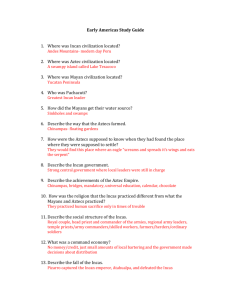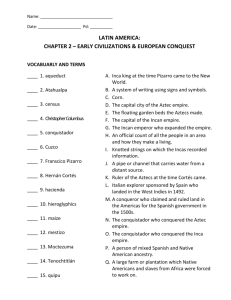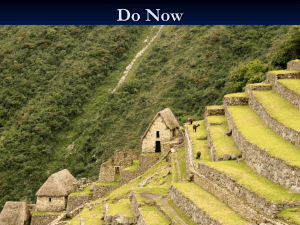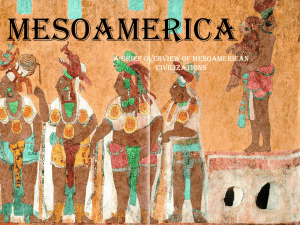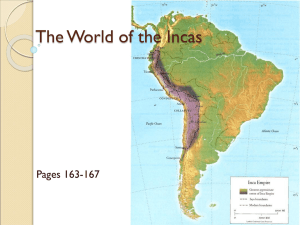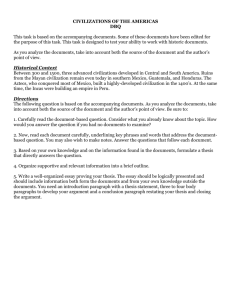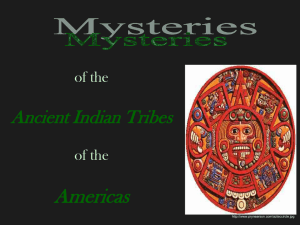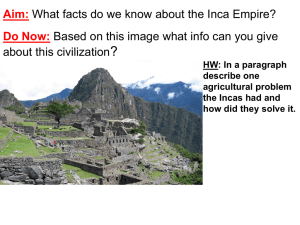Chapter 12 – Early Civilizations of the Americas Chapter 12
advertisement
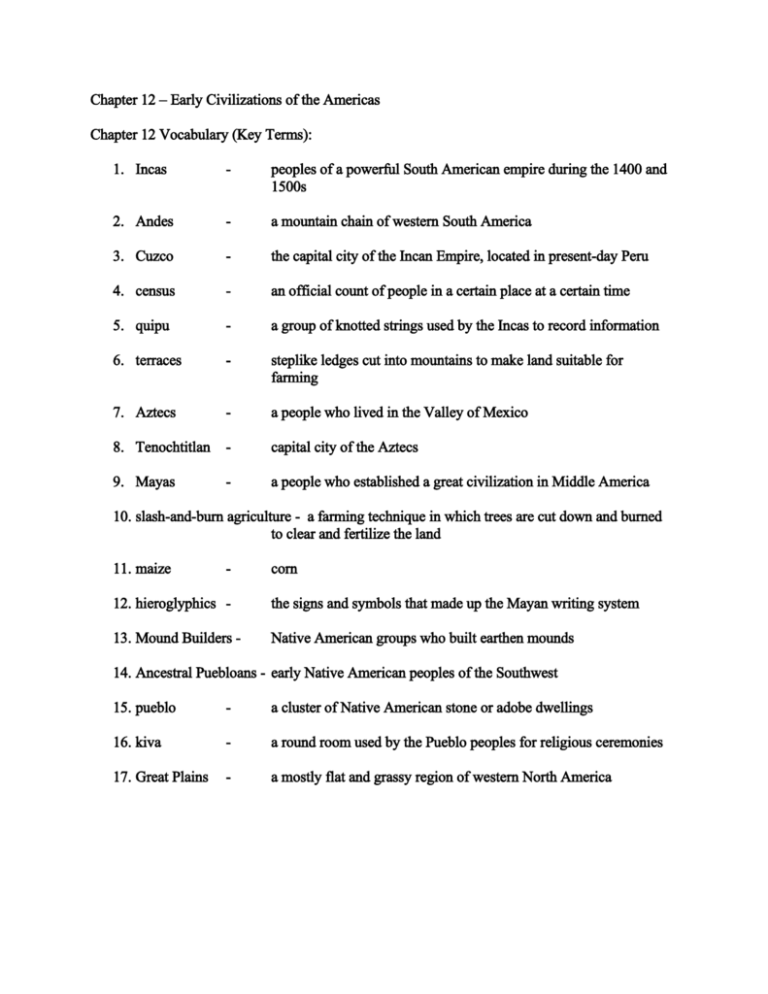
Chapter 12 – Early Civilizations of the Americas Chapter 12 Vocabulary (Key Terms): 1. Incas - peoples of a powerful South American empire during the 1400 and 1500s 2. Andes - a mountain chain of western South America 3. Cuzco - the capital city of the Incan Empire, located in present-day Peru 4. census - an official count of people in a certain place at a certain time 5. quipu - a group of knotted strings used by the Incas to record information 6. terraces - steplike ledges cut into mountains to make land suitable for farming 7. Aztecs - a people who lived in the Valley of Mexico 8. Tenochtitlan - capital city of the Aztecs 9. Mayas - a people who established a great civilization in Middle America 10. slash-and-burn agriculture - a farming technique in which trees are cut down and burned to clear and fertilize the land 11. maize - corn 12. hieroglyphics - the signs and symbols that made up the Mayan writing system 13. Mound Builders - Native American groups who built earthen mounds 14. Ancestral Puebloans - early Native American peoples of the Southwest 15. pueblo - a cluster of Native American stone or adobe dwellings 16. kiva - a round room used by the Pueblo peoples for religious ceremonies 17. Great Plains - a mostly flat and grassy region of western North America Chapter 12 – Section 1 – South America and the Incas Obj: the geography of the Americas; the Incan empire of South America The Incas was not the first culture to develop in the Americas. Many groups had lived there for thousands of years Individual cultures developed different ways of life, based on their geographical setting Some lived in the dense forests Some lived along the fertile river valleys Some lived among rocky cliffs The Mountain Empire of the Incas At its peak, the powerful South American empire of the Incas measured 2,500 miles. (4,020 k) Growth of an Empire 1200 – the Incas settled in a small village on a high plateau in the Andes This village, names Cuzco, became the Incas’ capital city and center of both government and religion. (“cuzco” means center in the Incan language) They extended their control over nearby lands through conquests. 1400s – lands ruled by the Incas had grown into an empire, and included as many as 12 million people. Its empire was run in an orderly way. Incan rulers gathered knowledge about events in their empire even though they could have happened as far as hundreds of miles away from its capital. Incan Government The Incan ruler was called Sapa Inca (the emperor) The emperor was believed to be related to the sun-god. Only the emperor o Owned all the land o Divided it among those under his rule o Nobles oversaw government officials All made sure the empire ran smoothly Officials used a census o Kept track of everyone’s responsibilities o Helped keep track of taxes paid (no money used, gave crops and animals to empire, or by doing special work) o Recorded which men worked as soldiers o Recorded which men worked on public projects (gold mining and road building) Farmers had to give the government part of their crops Women had to weave cloth In return for responsibilities, the empire took care of the poor, the sick and the elderly. Official language – Quechua (Kech wuh) Inca did not have a written language had a complex method of keeping records: quipu (kee poo) o a group of knotted strings o each quipu had a main cord with several colored strings attached o the colors represented different items o knots of varying sizes recorded numbers o recorded information such as: births deaths harvests o relay runners carried quipus across vast networks of roads and bridges to keep the government informed about distant parts of the empire roads carried relay runners, Incan armies and trade caravans (helped unify the vast empire) Lasting Achievements Achievements still amaze people today they controlled thousands of miles of paved roads, massive walls, and mountaintop buildings. All done with only stone hammers and bronze chisels. o Much of what they built hundreds of years ago with only those tools still stands today. They took advantage of their environment. o Used stone for many purposes o Constructed walls and buildings without the use of mortar or cement o Stone was even used to increase farm production Little natural farmland Andes are steep, dry and rocky Terraces were built Allowed Incas to farm on sloped that would otherwise have been too steep. Stone terraces held the soil in place, would not be washed away by rain. o Stone-lined aqueducts Decline of the Incan Empire 1400s – Incan Empire reached its peak It lasted for less than 100 years after that. Fighting among ruling family members Workers started to rebel against the strict government 1530s – Spanish conquistador – Francisco Pizzaro arrived in South America He wanted to explore the region He wanted to conquer its people The Incan emperor welcomed Pizzaro (he did not know of Pizzaro’s intentions) He trapped the Incan emperor, tricking him and his men (who were unarmed) Pizzaro captured the emperor and killed his men Spanish had superior weapons They also carried disease (smallpox and measles) o Killed much of the Incan population Spanish quickly gained control of the vast Incan Empire They tried for decades, but the Incas never succeeded in regaining their rule of the land. Chapter 12 – Section 2 – Cultures of Middle America Obj: the Mayan culture of Middle America; the powerful Aztec empire The Culture of the Mayas Before the Aztec empire, there were ancient peoples called the Olmec. They lived along the Gulf Coast from about 1200 BC – 600 BC Known for their pyramid shaped temples Huge carved stone heads Later, an important culture developed in parts of Central American and the Yucatan Peninsula to the north. The Yucatan Peninsula is located at Mexico’s southeastern tip. These people are known as the Mayas. Established a great civilization Built many cities in this region of Middle America Influenced by the Olmec Their way of life lasted for many centuries. From 250 to 900 900 AD left their environment for some unknown reason Theories: o Drought o Crop failure o War disease o Overuse of natural resources o People’s rebellions o Natural disaster A Farming Culture Their life was based on farming Slash-and-burn agriculture Planted seeds o These techniques had to be repeated as land wore out They grew a variety of crops: o Beans o Squash o Peppers o Papayas o Avocados o And the most common, maize Maize so important that they had a god of corn And because it needed rain and sun to grow, there were gods of rain and sun Centers of Religions and Government Its region divided into several city-states o Each city-state had its own ruler o Each served as a religious and governmental center o Priests and nobles important leaders They lived in palaces within the city o Festivals were held to honor Mayan gods o Tempe-pyramids sites for such religious ceremonies Which included human sacrifices o Mayan priests developed calendars to follow seasons and plan religious ceremonies Many were mathematicians System of writing signs and symbols was called hieroglyphics Hieroglyphics were used to record information in books made from barks of fig trees A Mayan Game o Pok-ta-tok was a game that was played in the outdoor courts. Court was the size of a football field Soccer and basketball combined Ball made of hard rubber Players had to try to knock it through a stone hoop set on a wall Ball could be hit with elbows, knees and hips, but not with hands or feet The ball could not touch the ground Mayans abandon their cities o AD 900 – Mayan civilization began to decline o People stopped building cities o They moved back into villages Reasons given earlier **today millionso f Mayas live in Middle America and continue some cultures and traditions of their ancestors. The Aztec Empire They settled in the Valley of Mexico in the 1100s Built a capital in the middle of Lake Texcoco o Capital city called Tenochtitlan By 1470s – conquered the surrounding lands Empire stretched 2,500 miles from the Gulf of Mexico to the Pacific Ocean One ruler o Heavy taxes (tribute) paid to him in the form of food, gold or slaves Waterways and Gardens Open plaza, also one or more towering pyramid-temples Raised streets of hard earth (causeways) connected cities to surrounding land Aqueducts carried water from one distance o another More farmland resulted in island gardens known as chinampas (floating gardens) o Soil dredged from lake bottom o Trees planted along edges o Reeds to keep in place o Canals used to transport produce by boats to marketplace Religion and Learning Aztec priests held ceremonies to bring good harvests Known as “warriors of the sun” Most important god was the sun god o Human blood sacrificed o Prisoners of war usually served as sacrifices Also prayed to the gods for victory at war Aztec priests created a calendar based on the Mayan calendar and their own knowledge of astronomy o Calendar had 13 periods o 20 days each Also kept records using hieroglyphics Tenochtitlan had schools and universities o Boys from noble families studied to be government officials, teachers or scribes Aztec Society Had a strict class structure Importance was as follows: o Emperor o Members of the royal family, nobles, priests and military leaders o Soldiers o Artisans and merchants o Farmers (who made up the largest class) o Slaves (usually prisoners captured in battle) War was a way of life in the Aztec Empire o Young men over age 15 o Well trained and well equipped Swords Bows and arrows Special armor made from heavy quilted cotton o Priests and government officials did serve in the military o Women could not be soldiers or military leaders They could train to become priestesses Most women had to be skilled at weaving Teenage girls not only weaved, they grinded flour to make tortillas and they cooked meals. The End of an Empire 1519 – Spanish conquistadors invaded the empire Some people conquered joined forces with the Spanish o Fought the Aztecs and tried to overthrow the emperor Moctezuma o Disease carried by the Spanish spread to the Aztecs and killed many of them 1521 – the Aztecs surrended to the Spanish (Hernando Cortes) The once-powerful Aztec Empire was at an end Chapter 12 – Section 3 – Cultures of North America Obj: The Mound Builders who lived in eastern North America; the cultures of the Southwest and Great Plains; the Woodland peoples of North America The Eastern Mound Builders Mound builders lived in eastern North America. Ocupied the region roughly between Minnesota and Louisiana, and between the Mississippi River and the Atlantic Ocean. Mound builders lived along the area’s many rivers, which provided Plenty of fish Fresh water They hunted wild animals for food, including: Deer Turkeys Bears Squirrels They gathered nuts such as: Acorns Pecans Walnuts Over time communities began to grow their own food Could stay in one place and form communities Early Mound Builders: The Adena Evidence discovered of early Mound Builders (600 BC) They lived in the Ohio Valley They were called the Adena o Constructed mounds usually less than 20 feet high o Certain mounds were tombs containing weapons, tools and decorative objects in addition to bodies o Because of items such as copper and seashells, it is believed that they had taken part in long-distance trade Little is known about their daily life Seems they had declined about 100 BC The Hopewell Culture 100 years before the Adena disappeared: o The Hopewell culture appeared along the Ohio and Upper Mississippi Rivers They did not have a highly organized society with a single ruler They lived in many small communities with local leaders Grew more crops than the Adena Traded over a wider area o From the Gulf of Mexico to Canada and the Rocky Mountains to the Atlantic Ocean 400s AD – trade across eastern North America faded out, and also stopped building mounds Historians not sure why, possible: o Climate may have turned colder and hurt agriculture o Severe drought o Invasion o Overpopulation The Mississippians 700 – began to flower in eastern North America Inhabited both small and large communities Lived along rivers and built mounds Grew new kinds of crops o Maize and beans an important staple of their diet o Both easily dried and stored in large amounts o Helped protect against drought and bad harvests Culture spread across present-day South and Midwest Long distance trade Increased population and major centers of government and religion These included: o Moundville (present-day Alabama) o Etowah (present-day Georgia) o Cahokia (the largest in present –day Illinois) By 1250 the population dropped **the disappearance of the last of the Mound Builders is as mystifying as the many earthworks they left behind Map Master – skills activity – The Mound Builders – lgp-8343 Peoples of the Southwest and the Great Plains Although mounds were built by the early Native American cultures, other peoples in North America adapted to different landscapes and climates to create distinctive structures. One of these groups created tall multistory homes from the available materials of the Southwest. Ancestral Puebloans Also known as the Anasazi Culture began about 100 Believed that the Chaco Canyon (present-day New Mexico) was the trading center for the region o Natives and trading center connected by a circuit of roads o Turquoise o Baskets o Pottery o Shells o Feathers American Southwest o Cold, dry winters o Hot,dry summers o Mostly poor soil o Little water o To capture rainwater they created a system of canals and dams o They also grew cotton o They homes were pueblos (clusters of stone and adobe dwellings helped keep them warm in the winter and cool in the summer) Had thick walls Round rooms called kivas used for religious ceremonies o Population and pueblos grew Some five stories and had hundreds of rooms Between 1275 and 1300 severe drought hit the region o Anasazi abandoned their pueblos and never returned Later Pueblo Peoples Ancestral Puebloan customs survived among later groups who lived in the same region. Called Pueblo peoples or simply Pueblos o Built apartment-style stone and adobe dwellings with kivas o Their crafts indluced: Weaving Basket-making Pottery Also, they were skilled farmers New Mexico and Arizona regions where the Pueblos lived receives only 8-13 inches of rain a year, but does have rivers Pueblos planted corn, squash, beans and other crops in river bottoms near their homes. They relied on intensive irrigation to raise these crops Hunting and gathering provided them with the food they could not grow They believed in many spirits, called kachinas Believed to control: o The rain o Wild animals o Harvests Peoples gathered for ceremonies that involved o Prayer o Dance o Singing Today’s Pueblo peoples, the Hopi and Zuni, keep many of these traditions alive The Plains Indians West of the Mississippi River and east of the Rocky Mountains Home to diverse groups of Native Americans (called Plains Indians) Individual groups had their own language and traditions Used sign language to trade with one another Some groups: o Mandan Farmers Lived in fenced villages along the Missouri River in lodges made of wood and earth o Sioux Followed herds of bison that roamed the plains Lived in teepees (tipis) Easy to take apart, carry and set up again Ideal for nomadic lifestyle After the arrival of Europeans, the lives of the Plains Indians change rapidly Had to share land with eastern Native Americans o Omaha (who were forced west by white settlers) Newly introduced horses, guns and railroads Most groups suffered from diseases Lost their land to European settlement Native American cultures began to break down **today there is a strong effort to revive these traditional cultures Peoples of the Woodlands Many lived in different parts of present-day Canada and the United States Peoples of the Northwest Coast: Hunted in the forests Fished in rivers and the Pacific Ocean full of salmon Lived in wooden homes Created remarkable structures (totem poles) o Carved and painted logs o Animals identified with the owner’s family line (like a family crest) o A symbol of the owner’s wealth Potlatch ceremonies Eastern woodlands – Native American groups o Iroquois Hunted in the forests Cleared land for farms Men usually at war, women were the farmers o 1500s – five Iroquois nations formed a peace alliance The Nations of the Iroquois League Mohawk Onondaga Cayuga Seneca Oneida Governed their own villages Met to decide issues that affected the group as a whole The best organized political system in the American when Europeans arrived
